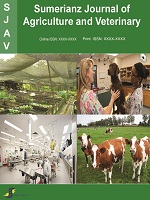Sumerianz Journal of Agriculture and Veterinary

Online ISSN: 2617-3077
Print ISSN: 2617-3131
Quarterly Published (4 Issues Per Year)
Journal Website: https://www.sumerianz.com/?ic=journal-home&journal=30Archive
Volume 5 Issue 1 (2022)
Improvement of Soil Nutrient and Yield of Maize Through the Application of Different Rates of Sawdust - Piggery Compost Fortified With Urea
Authors : Dania S. O. ; Ogbeide L. ; Michael C. G.
DOI : doi.org/10.47752/sjav.51.14.19
Abstract:Fortification of compost with inorganic fertilizer is necessary to compliment for some deficient nutrient in organic manure to improve soil fertility and crop yield. This experiment was carried out at Ambrose Alli University Teaching and Research Farm, Ekpoma, Nigeria and it was fitted in a Randomized Complete Block Design (RCBD) with seven treatments replicated thrice. The treatments were; Control, 2 tonnes of saw dust piggery compost + 75Kg/ha of urea, 4 tonnes of sawdust piggery compost + 75kg of urea, 6 tonnes of sawdust piggery compost + 75kg of urea (75kg Urea +6 SPC), 8 and 10 tonnes of compost, 150kg/ha of urea. Data collected were analysed using ANOVA and LSD was used to separate means. It was observed from the initial soil test that the soil nutrients status was below critical levels and this necessitate the application of the fertilizer to improve the fertility status of the soil. The application of 75kg Urea + 6 SPC significantly (p≤0.05) increased the soil nutrient status compared to other treatments. The growth, cobs weight, dry matter and grain yield of maize were significantly (p≤0.05) higher with application of 75kg Urea +6 SPC compared to other treatments. Also, the nutrient uptake of maize was significantly (p≤0.05) higher with application of 75kg Urea + 6 SPC. In conclusion, the application of 75kg Urea +6 SPC significantly (p≤0.05) increased the soil nutrient status, growth and the yield of maize.
Defoliation Frequencies of Forage Legumes: Effects on Yield and Nutritive Value for Beef Cattle Production
Authors : Tersur Theophilus Akpensuen
DOI : doi.org/10.47752/sjav.51.6.13
Abstract:A study was conducted to determine the effect of cutting frequencies for 2 temperate (Trifolium pratense and Trifolium repens) and 2 tropical (Stylosanthes guianensis and Centrosema molle) forage legumes on dry matter yield and nutritive value for beef cattle production in a cool tropical environment of Jos, Nigeria. It was a factorial experiments with four forage legumes and three defoliation frequencies (4 x 3) making twelve treatments combinations arranged in a randomized complete block design and replicated four times. The study was conducted in 2016 and 2017. The result showed that total dry matter yield (DMY) was higher (p<0.05) in T. pratense in 2017 (3.06 t/ha), while C. molle produced least DMY (1.01 t/ha). The temperate species performed better after each cut in DMY. Crude protein content was higher (p<0.05) in T. repens (26. 12 %) at the third cut. The tropical species were higher (p<0.05) in fibre contents. Dry matter intake (3.88 %), digestible dry matter (71.24 %) , total digestible nutrients (70.2 %) and relative feed value (214.53) were all higher (p<0.05) in T. repens at third cut. The temperate forage legumes generally showed more resilience to cuttings compared to the tropical species. Therefore the crops can be grown in the cool tropical environment of Jos, Nigeria as supplementary forage feeds.
The Ecological Role of Deadwood Materials as Habitat Providers at Kanawa Forest
Authors : Abubakar Sadiq Yakubu ; Ahmad Nasiru Muhammad ; Sulaiman Mohammed ; Istifanus Jesse ; Amina Haruna Aliyu ; Danladi Mohammed Umar
DOI : doi.org/10.47752/sjav.51.1.5
Abstract:Deadwood; snags or downed coarse are important habitat features for many forest-dwellers. They influence ecological activities and biodiversity. This study reported on the ecological role of snags and downed coarse as habitat providers. The research was conducted at Kanawa forest reserve. Systematic random sampling method was employed to lay 4,000m line transects (500m each) across the forest edge (FE) and core forest (CF) of the reverse. On each transect, five 20m x 20m plots were established at 100m interval to assess the deadwood, their colonizers and relationship. Different animal species were recovered using snags as their prepared home or hiding place. Salamander (31%) was found in significantly greater frequencies in the core forest as colonizer. Downed coarse accommodate diverse animal species with only one plant, Chick wee. Forest edge has the transect with higher numbers of colonizers, whereas core forest has the optimum percent of downed coarse. On colonization and relationship, the interaction is either as saprophyte, use as niches or habitat. The organisms are Reptiles, Isopoda, Hymenoptera and Herbs. Among the animate thing, forest edge possess more and diverse colonizers.


